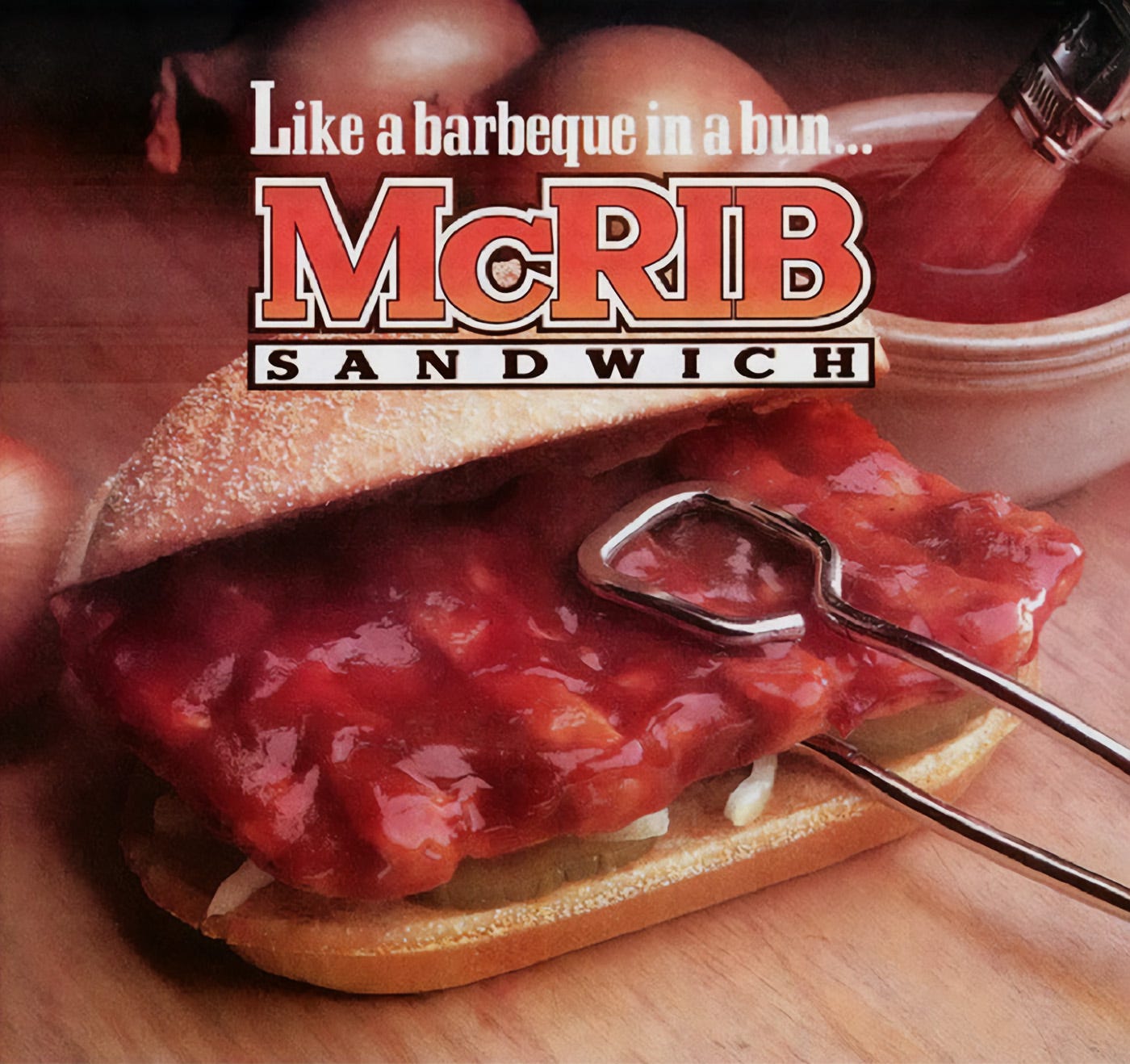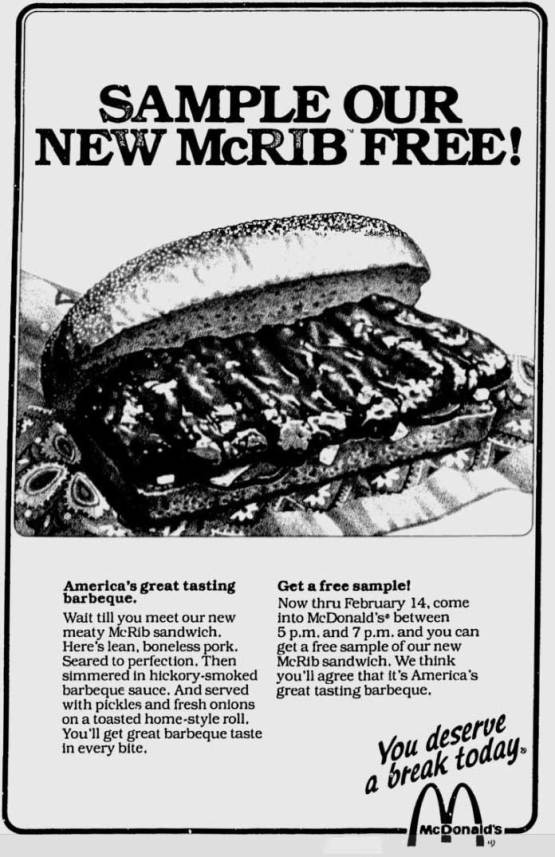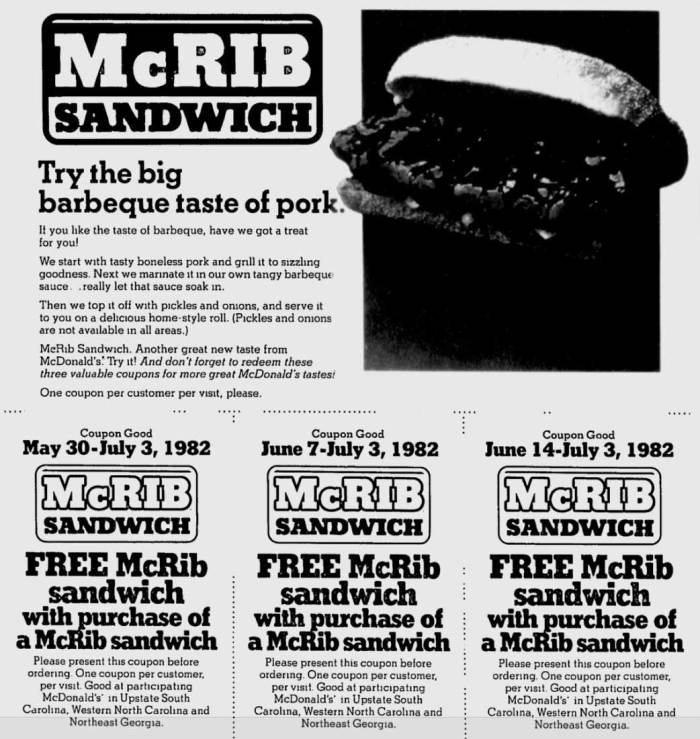The History of the McRib
It's like a BBQ in a bun without the bones.
I enjoy trying new fast food. I like the novelty of it all, the combination of food science and commerce, is just irresistible. Now I know fast Food is often a divisive subject. Love it or hate it, though. It is here to stay. In 2018 alone 36.6 percent of the adult population of the United States consumed fast food on any given day and that number is probably not going down. Among fast-food offerings, one menu item from the most well-known chain of restaurants in the world is perhaps the most controversial, the McDonald’s McRib.
The Origin of the McRib
The McRib, which is a pork product, would not exist if not for another McDonald’s item, the Chicken McNugget. The not so humble Chicken McNugget was created through the combined effort of Herb Lotman of Keystone Foods and McDonald’s first Executive Chef René Arend in 1979.
They were a huge hit, which led to shortages and complaints from both customers and franchisees.
This shortage would lead directly to the creation of the McRib. In a 2009 interview, Arend said,
“There wasn’t a system to supply enough chicken. We had to come up with something to give the other franchises as a new product. So the McRib came about because of the shortage of chickens.”
Chef René Arend
Now Arend could have taken a pork patty slapped it on a hamburger bun and been done with it, but he took care to try and make the McRib an interesting creation.
Iwould like to take a moment to ask you to reset your expectations on “interesting.” The mainstream trend towards unprocessed food was still years away when Arend was given his task. So the highly processed nature of the McRib, while always a bit controversial, was not as controversial as it has become.
What is Keystone Foods?
Now owned by Tyson Foods. Keystone Foods is an important part of the fast-food supply chain. They supply beef, chicken, fish, and pork to many of the world’s largest restaurant chains.
The inspiration for the McRib came from Southern BBQ. Arend was trying to capture the flavor of pulled pork sandwiches he had enjoyed in South Carolina. But the challenge was making it easier and less messy to serve at a larger scale. A patty was in order, but what sort of patty?
They would eventually settle on an elongated patty that has raised bumps that are shaped like ribs. According to author Anastacia Marx de Salcedo who wrote the excellent Combat-Ready Kitchen: How the U.S. Military Shapes the Way You Eat. The basis for the food technology to make the McRib patty was originally developed by the United States Military to use in MREs (Meal, Ready to Eat). This process was furthered by the University of Nebraska and McDonald’s.
Very little Rib Meat in a McRib
The McRib is a shaped patty. No ribs involved, that means no bones and little to no rib meat. According to Rob Cannell, director of McDonald’s U.S. supply chain in 2009, “Primarily, it’s shoulder meat. The pork meat is chopped up, then seasoned, then formed into that shape that looks like a rib back. Then we flash-freeze it. The whole process from fresh pork to frozen McRib takes about 45 minutes.”
Pork Shoulder sounds pretty normal as a cut of meat, but they say primarily, it does seem other cuts could be involved. Dr. Roger Mandigo, who helped to perfect the technology behind the McRib cowrote a 1995 article that explains the process.
Restructured meat products are commonly manufactured by using lower-valued meat trimmings reduced in size by comminution (flaking, chunking, grinding, chopping or slicing). The comminuted meat mixture is mixed with salt and water to extract salt-soluble proteins. These extracted proteins are critical to produce a “glue” which binds muscle pieces together. These muscle pieces may then be reformed to produce a “meat log” of specific form or shape. The log is then cut into steaks or chops which, when cooked, are similar in appearance and texture to their intact muscle counterparts.
from Utilization of Twin Screw Cold Extrusion to Manufacture Restructured Chops from Lower-Valued Pork
It’s a fascinating bit of food science. That gives greater control over food attributes in a product. Although it is probably not for those who are squeamish about the origin of their foods.
Testing the McRib
They started testing the McRib in Kansas City in 1981 before bringing it to other markets in the early months of 1982. A few months into that year, media outlets were starting to mention this brand new offering. A lot of it appears to be through the efforts of McDonald’s marketing and coverage by the UPI news agency.
Reading through the press at the time, people seemed to see the McRib as the next coming of the McMugget. McDonald’s did everything to encourage that idea.
In 1982, Stephanie Skurdy, who was Manager of Media Relations at McDonalds said, “So far its been enthusiastically received, and we’re enthusiastic about that.” At this point, the McRib was being offered in around 2,000 of McDonald’s 5,600 restaurants. This was considered “test mode” and according to their Advertising Manager at the time, Neil Perry, this test would run for at least two more years, but the company was, “confident it’s going to make it.”
The Pork Industry is Excited
When the McNugget was released, it was a boon to chicken suppliers. So you know that pork suppliers were drooling at the prospect of a successful fast food pork sandwich. Of the major industrial meats, it was the one that was not being consumed in this lucrative market.
At the time of its release over 30% of US beef was being consumed away from home compared to just 12% of pork. The idea that 5600 McDonald’s outlets might be serving 300-400 pounds of pork per week was noteworthy.
If these McDonald’s numbers stood up, McDonald’s would only be consuming 0.000067% of the pork produced in the United States annually. But it was hoped that this would cause other restaurants to consider serving more pork.
Tom McDermott, Director of Communications for the National Livestock and Meat Board said, “Were excited that it will cause a lot of others in the food service industry to look at pork. Pork has been overlooked by the food service industry in our opinion. Pork hasn’t benefited as beef has from the food service boom that began in the 1960s.”
The McRib wasn’t just a new food. It was going to bring new life to pork and make America a pig gobbling nation. It was just a matter of time.
The Rise and Fall of the McRib
McDonald’s would continue to expand the McRib into new locations. In 1983, this offering would peak at 3,500 locations. The marketing was working and many people were running out to try the McRib. Unfortunately, trying it is all they did. Repeat customers just didn’t appear. Feedback focused on two key aspects of the sandwich, its taste and its messiness.
Things weren’t looking good for McDonald’s, but they didn’t give up and continued their marketing push. According to a 1984 article in the Pittsburgh Post-Gazette, they did this with money from a National Pork Industry Group as part of a cooperative agreement with McDonald’s. This was the first such initiative between a commodity group and McDonald’s and it just demonstrates how important the McRib was to the providers of pork.
The initial wave of McRib advertising started in late 1981. That wave would peak in 1982. But by 1983, it was becoming apparent to both McDonald’s and the pork industry that the McRib was not the runaway success they hoped it would be and the advertising dried up.
Several articles appear in 1983 and 1984 claiming that the McRib was a giant mcstake or a mcflop. While the pork industry saw it as a setback, they also saw a silver lining. According to the Vice President of the National Livestock and Meat Board’s pork program, Mark Thomas, “We may have taken some steps backward,” then added that the McRib, “really brought the idea and concept many steps forward.”
It helped that McDonald’s added pork sausage to their breakfast menu at this time. While not the massive boon that the industry dreamed of, it was a new way to put pork on people’s plates.
A McRib theory based on Scarcity
While it was just pure speculation, the data in the 2011 article A Conspiracy of Hogs: The McRib as Arbitrage by Willy Staley lines up the pricing of pork as a commodity with the release of the McRib. It is speculative, but if it is true, it is a straightforward lesson in economics.
The Cult of the McRib
The McRib was going the way of other McDonald’s failures like the McDLT, Chopped Beefsteak Sandwich, and Onion Nuggets. But it turns out, the McRib was something different. McDonald’s would revive the McRib for limited times and when it did, the group of people who liked this BBQ on a bun started to take notice. McDonald’s even started running ads for the McRib, including a very memorable campaign narrated by Tony Joe White in 1989.
Slowly but surely the McRib started to appear again in select McDonald’s restaurants seasonally. The McRib might not have changed the fast food world, but it had found its audience and they were loyal. This loyalty was skewered wonderfully in 2003 by The Simpsons in I’m Spelling as Fast as I Can.
In the episode, Homer discovers the magic of a new Krusty Burger sandwich, the Ribwich. Eating one is a mind-altering experience that causes him to abandon other things in his life to become a Ribhead. He and his fellow Ribheads travel around the country in a hippie-like caravan eating Ribwiches. It’s both a fun parody of Grateful Dead culture and the growing following of the McRib.
The McRib goes Online
Widespread adoption of the internet gave rise to online communities and the McRib’s quickly grew. Early fan websites would be replaced with communities on sites like Facebook and fan accounts on Twitter, but it was a site that started in 2008 that would capture the attention of the world.
In the new millennium, the McRib had returned to select restaurants. Unfortunately where and when they would show up was a big mystery and you never knew if a McDonald’s had one unless you went in and ordered one.
Alan Klein was a fan of the McRib who just wanted to help his fellow McRib enthusiasts find and enjoy what they craved. So he started the McRib Locator. It started at a simple site where people could report and find McRibs, but it has grown into a clearinghouse for all things McRib with updated news around releases and a Facebook community with over 15,000 followers.
It is a solid fast food fan community, but it also might be one of the largest dedicated to a single seasonal fast food item.
alt.food.mcdonalds
One of the earliest mentions I can find on the open web right now is in Google Groups. In their archive of Usenet posts, you can find a post from 1992 called, Deprived Europeans?
In a response to the original poster, Curtis Johnson says,
Hey all you McRib lovers out there….I don’t know if this thing is going nationwide or not, but in the Madison WI region, McDonald’s is having a “Bring Back the West” promotion starting on or around March 16.
The promotion will include bringing back the McRib and the Western style Omelette (for breakfast) for a limited time. Plus, some locations will have lower prices on the Chicken fajitas and Breakfast Burritos. Bu the stores that will participate in that are still unknown to me.
Happy McRib eating……and make sure you wear your bib.
The Sandwich that won’t Die
Slowly but surely the McRib’s following has grown. Not only here in the United States, but abroad. In fact in other countries the McRib is available with variations. For example in Nicaragua, you can get four types of McRib.
Standard McRib
McRib with Onions Rings
McRib with Cheese
McRib with Bacon
All of them sound delicious and they demonstrate how we haven’t even begun to figure out interesting things to do with the McRib.
Enthusiasm for them is so high right now that McDonald’s has announced that the next seasonal offering of McRib will not just be in select locations, but it will go nationwide in the United States. So now everyone who can get to a McDonald’s will have the opportunity to have one.
Once it starts, it is unclear how long this current offer will last. It will probably last just a couple of months before disappearing again. Then people can begin speculating on the demise of the McRib once again. We might not know exactly when the McRib will appear in the future, but I think you can bet that it most certainly will again and again.






Over the years, I'd seen so much hype about the McRib that I just had to try one.
Meh. Bland, overly sweet, no taste at all. Like you poured the cheapest bottle of "barbecue sauce" in the Safeway over some cheap meat.
Great research. Well done, you.